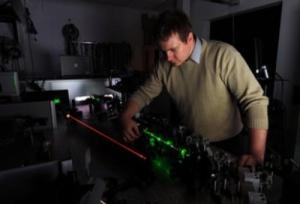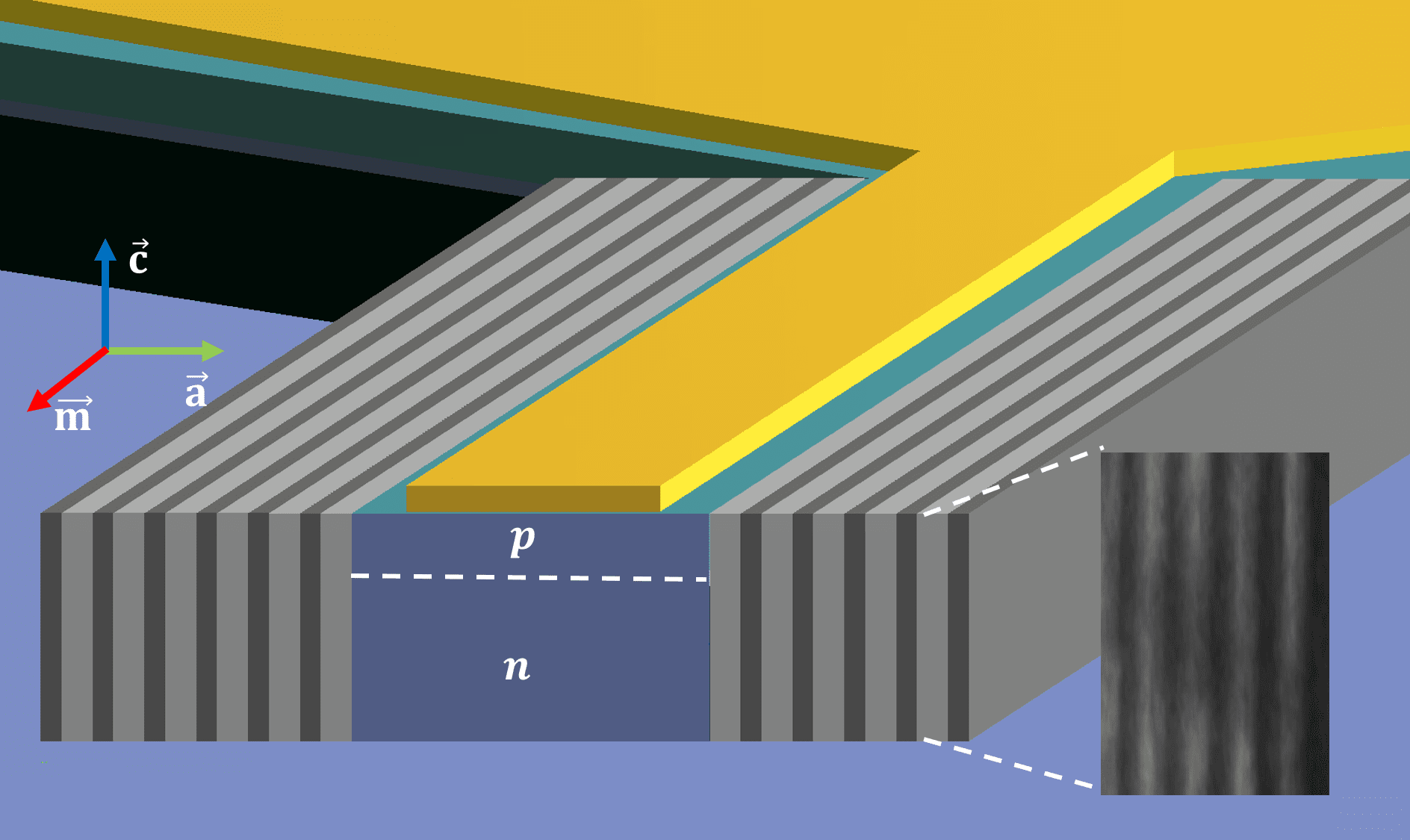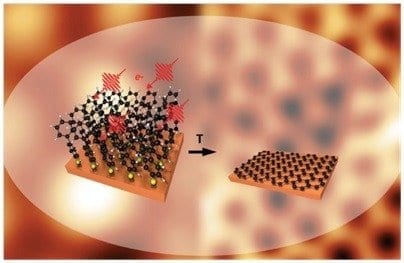
Can a device with a footprint not larger than half of a desktop produce power a few dozen times higher than that generated by all nuclear power stations worldwide?
A compact new generation optical amplifier has been constructed by physicists from the Laser Centre of the Institute of Physical Chemistry of the Polish Academy of Sciences and the Faculty of Physics of the Warsaw University. The apparatus is extremely efficient and small enough to fit on a desktop and is able to generate over 10 terawatt light pulses.
Can a device with a footprint not larger than half of a desktop produce power a few dozen times higher than that generated by all nuclear power stations worldwide?
The answer is: “yes – in a pulse”! A new parametric amplifier constructed in the Laser Centre at the Institute of Physical Chemistry of the Polish Academy of Sciences (IPC PAS) and the Faculty of Physics of the Warsaw University (FUW) allows to produce very short (femtosecond) laser pulses with a giant power of 10 terawatt. The new amplifier represents an important step towards construction of compact, portable, relatively low cost high power laser devices that could revolutionize, e.g., anti-cancer therapies.
“Theoretically, the efficiency of parametric amplifiers can reach over 50%. In practice, the best amplifiers of this type are operated at an efficiency of about 30%. We have reached this level already now, and what’s more, in a really compact device”, says Dr Yuriy Stepanenko (IPC PAS), the chief constructor of the amplifier, adding: “We still improve our setup. In the coming months we are going to increase the amplifier’s efficiency by another a few per cent on one hand, while on the other we intend to increase the power of laser pulses up to a few tens of terawatts”.
Most lasers generating ultrashort pulses amplify light using sapphire crystals doped with titanium ions. An external laser is used to pump energy into the crystal, and a fraction of the energy is subsequently taken over by a laser beam being amplified. The method has numerous
disadvantages. One of the major ones is that the crystals warm up strongly leading to adverse distortions of the cross section of the laser beam. As a result, the crystals must cool down virtually after each laser shot.
Luckily, non-linear optical effects can be used to construct amplifiers of a different type. These parametric amplifiers transfer effectively energy directly from the pumping laser beam to the beam being amplified. As the input energy is not stored anywhere, there are no adverse thermal effects, and the amplified pulses have excellent parameters. Parametric amplifiers can amplify light by hundreds of millions of times on an optical path of a few centimeters only. That’s also why they are really small in size, especially as compared with the standards of high power optics. The instrument from the Laser Centre of the IPC PAS and the FUW comfortably fits half of a typical
desktop.
The new amplifier will be used for construction of an x-ray source and to generate experimentally protons and secondary neutrons.
One of the long-term objectives of the research on parametric amplifiers is to generate laser pulses with power of 200 TW and higher. Such powerful light pulses could be used for accelerating protons to energies that are useful in medical therapies, for instance to selectively kill cancer cells.
The existing techniques for proton acceleration require construction of huge and high cost accelerators. High power lasers would allow for significant increase in availability of the state-of the-art proton therapies, with simultaneous radical reduction of treatment costs for cancer patients.
The Latest Bing News on:
Optical amplifier
- Q3 2024 Lumentum Holdings Inc Earnings Callon May 6, 2024 at 11:03 pm
Alan S. Lowe; President, CEO & Director; Lumentum Holdings Inc. Christopher W. Coldren; Senior VP and Chief Strategy & Corporate Development Officer; Lumentum Holdings Inc. Kathryn Ta; VP of IR; ...
- Big Audio Deal: $1500 Off Rotel’s S14 Network Streaming Amplifier (Now $999)on May 6, 2024 at 10:46 pm
The Rotel S14 also includes coaxial digital, optical digital, analog RCA ... output as well as preamp outputs in case you want to upgrade to a more powerful amplifier down the road. The S14’s on-board ...
- Photonic Integrated Circuits (PIC) Market Surging Towards US$ 9.4 Billion by 2032, Forecast Indicates 21.5% CAGRon May 6, 2024 at 7:25 pm
The global photonic integrated circuits (PIC) market saw significant growth in 2021, reaching a total sales value of approximately US$ 1.1 Billion. The outlook for this market is even more promising, ...
- NAD Electronics Introduces the C 379 HybridDigital DAC Amplifieron May 6, 2024 at 10:10 am
NAD Electronics, a leading manufacturer in high-performance audio, today announces the launch of its new Classic Series amplifier, the C 379 HybridDigitalÔ DAC Amplifier at the HIGH END Munich ...
- Multiplexed neuron sets make smaller optical neural networks possibleon May 6, 2024 at 8:48 am
Seeking to improve the practicality of optical neural networks that use wavelength division multiplexing, a research team developed a structure called multiplexed neuron sets and a corresponding ...
- Mind-blowing optical illusion causes letters to change colours - eye expert reveals whyon April 30, 2024 at 9:00 am
If you're looking for your mind to be blown, why not take a look at this crazy optical illusion that will have you believing that things are moving within the image?
- Passive Optical Component Market CAGR of 17.6%, Growth Analysis, Size, Prominent Players, Overview, and Forecast 2024 to 2032on April 28, 2024 at 10:49 pm
optical amplifiers, fixed and variable optical attenuators, optical transceivers, optical circulators, optical filters, WDM/WDDM, and others. By application this market is classified into interoffice, ...
- Optical Illusion: Test your sharp eyes by finding the designer's sewing machineon April 26, 2024 at 12:30 am
Helping the designer spot a sewing machine through an optical illusion tested observation and problem-solving skills with hints fo... Read More Helping the designer spot a sewing machine through ...
- Best headphone amplifiers of 2024, tested for pristine soundon April 25, 2024 at 11:00 am
Best headphone amplifiers of 2024, tested for pristine sound - Pump up the personal jam with an array of exceptional amps here for your ...
- Optical Transceiver Market Size growing at a CAGR of 13.0% [2029]on April 24, 2024 at 5:00 am
According to a research report "Optical Transceiver Market by Form Factor (SFF and SFP; SFP+ and SFP28; XFP; CXP), Data Rate, Wavelength, Fiber Type (Single-mode Fiber; Multimode Fiber), Connector (LC ...
The Latest Google Headlines on:
Optical amplifier
[google_news title=”” keyword=”optical amplifier” num_posts=”10″ blurb_length=”0″ show_thumb=”left”]
The Latest Bing News on:
Low cost high power laser devices
- Leading Edge Semiconductor Company Places Multi-System Laser Annealing Order Including First Nanosecond Annealing Systemon May 7, 2024 at 2:00 am
The order includes LSA201™ Laser ... high temperature annealing while staying within reduced thermal budgets of advanced devices at leading-edge nodes. The NSA500 system extends annealing capabilities ...
- U.S. Military Is Using Laser Weapons In Battleon May 6, 2024 at 10:02 am
Prototype laser air defense systems deployed by the U.S. Army have taken out enemy drones in the Middle East, an Army official told Forbes.
- JVC Announces Four New Premium D-ILA Laser Projectors, All With ‘8K’ And 4K/120 Supporton May 2, 2024 at 3:00 am
All four models are illuminated by a new iteration of JVC’s proprietary BLU-Escent Laser ... low latency Game modes when a game source is detected. As you’d expect of any premium projector these days, ...
- Laser-driven particle accelerationon April 25, 2024 at 3:56 am
The acceleration of charged particles to ultra-high energies by intense laser pulses could be made a reality by petawatt laser facilities. Laser-based approaches promise a low-cost, compact and ...
- Airborne single-photon lidar system achieves high-resolution 3D imagingon April 24, 2024 at 5:00 pm
Researchers have developed a compact and lightweight single-photon airborne lidar system that can acquire high-resolution 3D images with a low-power laser. This advance could make single-photon ...
- Best color laser printers for 2024: tested and reviewedon April 11, 2024 at 5:00 pm
For shoppers worried about the long-term ink costs, you'll find color laser printers surprisingly affordable. Laser printers use toner, which lasts a very long time, delivering a low cost per page ...
- High-energy laser weapons: How they work, what they are used foron March 8, 2024 at 8:45 am
high-energy laser weapons are likely to continue to evolve with increased power levels that will expand the range of targets they can be used against. Emerging threats posed by low-cost ...
- Low power, high impacton August 24, 2023 at 10:57 am
Reducing the operating voltage and power consumption ... Improved device uniformity and reliability, as well as the development of low-cost high-throughput material processing and patterning ...
- Diode Lasers Informationon February 11, 2018 at 6:26 am
Low power and current ... Also, as electrical devices, they are prone to static interference and gradual loss of efficiency over time. Diode lasers represent the vast majority of the laser market due ...
- Lattice Diamond 2.0 Software Unleashes Powerful Design Tools for the New Low Cost, Low Power LatticeECP4 FPGA Familyon July 15, 2012 at 7:00 pm
The LatticeECP4 FPGA family features low cost, low power mid-range devices with numerous high performance innovations. The family offers standards-compliant multi-protocol 6G SERDES in low cost ...
The Latest Google Headlines on:
Low cost high power laser devices
[google_news title=”” keyword=”low cost high power laser devices” num_posts=”10″ blurb_length=”0″ show_thumb=”left”]










